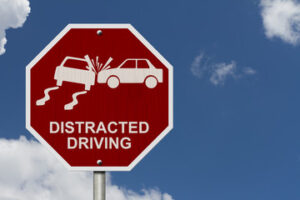
We are often multitasking, trying to keep up with responsibilities. Even the best of us will find ourselves trying to multitask behind the wheel despite knowing it’s unsafe. Unfortunately, the second we look away from the road can have life-altering consequences. Distracted drivers may not have malicious intent, but their actions can cause a lot of pain and discomfort. As a result of another person’s actions, you may be left with serious injuries and financial burdens that you can’t address on your own. This is where personal injury claims come into play.
When the unexpected occurs, the consequences of distracted driving leave you struggling with the aftermath of a car accident. The seasoned Texas car accident lawyers at Byrd Davis Alden & Henrichson, LLP can help you navigate the complexities of a claim and obtain fair compensation. With a legacy spanning over six decades as Austin’s oldest personal injury law firm, we understand the intricacies of distracted driving claims and have successfully advocated for countless victims.
Understanding Distracted Driving
Distracted driving is a serious concern on Texas roads, and it’s essential to understand what it entails. Distracted driving refers to any activity that diverts a driver’s attention away from the primary task of operating a vehicle. This can include a range of behaviors, such as:
- Using a cell phone or other handheld device while driving
- Eating or drinking while driving
- Engaging in conversations with passengers
- Adjusting the radio or other in-car entertainment systems
- Reading or writing while driving
- Grooming or personal hygiene activities while driving
These activities can be categorized into three main types of distracted driving:
- Visual distraction: taking your eyes off the road
- Manual distraction: taking your hands off the wheel
- Cognitive distraction: taking your mind off the road
Understanding the different types of distracted driving can help you identify the risks and take steps to prevent accidents. By being aware of these distractions, drivers can make more conscious decisions to stay focused on the road, thereby reducing the likelihood of distracted driving accidents.
The Dangers of Distracted Driving
Distracted driving is a leading cause of car accidents in the United States, and the statistics are alarming. According to the National Highway Traffic Safety Administration (NHTSA), distracted driving was responsible for 3,166 deaths in 2017 alone. In Texas, distracted driving accidents are a major concern, with many crashes resulting from this behavior.
Some key statistics on distracted driving accidents include:
- 9 people are killed every day in the US in car accidents involving a distracted driver
- 1 in 5 crashes in Texas involves distracted driving
- Distracted driving is the most common type of driver error, accounting for 10% of all fatal crashes
These statistics highlight the importance of addressing distracted driving and taking steps to prevent accidents. By understanding the scope of the problem, drivers can be more vigilant and take proactive measures to avoid becoming another statistic in distracted driving accidents.
How to Prove Distracted Driving in Car Accident Claims
Distracted driving has become a leading cause of car accidents, posing a significant threat to road safety. Proving a distracted driving accident is crucial in personal injury claims, as it encompasses a range of activities that divert a driver’s attention away from the primary task of operating a vehicle. Common distractions include texting, talking on the phone, eating, adjusting the radio, and interacting with in-car infotainment systems.
In Texas, texting while driving has been explicitly prohibited by law since 2017, making it a primary offense. However, other forms of distraction are not as easily regulated, making the evidence-gathering process crucial for establishing liability in a car accident claim.
Gathering Evidence to Prove Distracted Driving
Proving distracted driving requires a comprehensive collection of evidence that establishes a driver’s negligence. Key pieces of evidence include:
- Cell phone records: Obtaining the at-fault driver’s phone records can provide valuable insights. Records indicating texting or phone calls at the time of the accident can strongly support a distracted driving claim.
- Witness statements: Eyewitnesses who observed the at-fault driver engaging in distracting activities can provide critical testimony. Their statements can corroborate your version of events and strengthen your claim.
- Police reports: Law enforcement reports may contain information about the at-fault driver’s behavior at the accident scene. It can be incredibly beneficial if an officer notes signs of distraction, such as admitting to phone use.
- Surveillance footage: If available, surveillance footage from nearby cameras can offer a visual record of the at-fault driver’s actions leading up to when the accident occurred.
- Expert testimony: Accident reconstruction experts or technology experts can provide professional opinions on the likelihood of distraction based on the circumstances of the accident.
In Texas, the comparative negligence rule applies, meaning that even if the plaintiff is partially at fault, they can still recover damages. However, proving distracted driving becomes more intricate when contributory factors are involved. A skilled car accident lawyer in Texas is crucial to effectively present the evidence, establish causation, and counter any arguments raised by the defense.
Role of Cell Phone Records in Proving Distraction
Cell phone records can play a crucial role in proving distraction in a car accident claim. If the other driver was using their phone at the time of the accident, their phone records can provide concrete evidence of their distraction.
Obtaining phone records typically involves filing a subpoena or court order to compel the phone company to release the records. Once obtained, the records can be analyzed to determine if the driver was using their phone at the time of the accident.
A skilled car accident lawyer can help you navigate the process of obtaining and analyzing phone records to build a strong case. They can also work with accident reconstruction experts to determine if the driver’s phone use contributed to the accident.
By understanding the role of cell phone records in proving distraction, you can better navigate the process of filing a successful personal injury claim. This evidence can be pivotal in establishing liability and ensuring you receive the compensation you deserve for your injuries and losses.
Work With an Experienced Car Accident Attorney Today
Looking away from the road for a moment can have serious consequences, and although we know this, it’s easy to make the mistake. However, these auto accident claims can cause severe injury and huge financial strife. Fortunately, by filing a successful personal injury claim, you can recover fair compensation that helps get you back on your feet.
At Byrd Davis Alden & Henrichson, LLP, we don’t just understand the law; we understand your story. Our legacy of over six decades as Austin’s oldest personal injury law firm is built on the commitment to stand with those who seek justice. If you’ve been a victim of a car crash, let us be the advocates you deserve.
Texas law outlines the implications of distracted driving, including the penalties for various distractions such as cell phone use while driving.
Your journey to healing and rightful compensation begins with a simple step—reach out to a car accident attorney from Byrd Davis Alden & Henrichson, LLP today. Schedule a consultation today by completing our contact form or by calling (512) 454-3751.

